FIFIE REEFED, WITH SMALL MIZEN
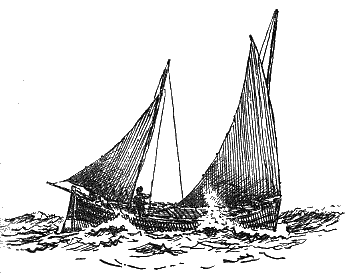
Owing to the length of these boats,
there would always be risk of their missing stays if no
mizen were used, as the sail would then be all upon the
fore part of the boat. Even in very rough weather,
therefore, a small jib-headed mizen is used to keep the
boat up to the wind, and facilitate the process of
staying. *2*
*1* In Scotland 'boom' is used for any out-rigged spar,
whether bowsprit or jigger-boom, fore or aft.
*2* The cost of one of these boats, including steam
hauling gear, sails and other outfit, used to be from
£500 to £600, but cannot now be quoted at less
than £700, owing to increased cost of material and
other causes.
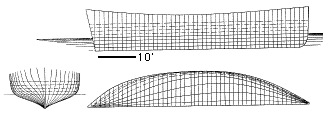
One recently built at Fraserburgh was 66 ft. keel and
70 ft. over stems ; 21 ft. beam outside gunwale, and 20
ft. inside plank ; 7 ft. deep inside, and 40 tons
register. The carpenter's account was £430 ; iron
work, £52 ; sails and outfit, £150, and steam
hauling gear, £105 ;-total, £737 ; and the
following outfit of sails, etc., was provided:
Foremast, 64 ft. long by 1 ft. 8 inches at the deck ;
mizen-mast, 55 ft. by 1 ft. 2 inches at the deck ;
jib-boom, 54 ft. by 1 ft. 1-1/2 inches ; foresail, 310
yards ; jib, 150 yards ; big mizen, 210 yards ; winter
mizen, 150 yards ; jib-headed mizen, 90 yards ; mid storm
mizen, 40 yards. The boat has also two canvas drogues or
floating anchors ; one, the old tow net-shaped canvas
cone, and the other, topsail-shaped, such as is carried
aboard the smacks that go to the Faroe and Iceland
cod-fishing. These drogues are also termed 'fly anchors'
by the fishermen. They are often used to check the way of
the boat when running into a crowded harbour. For this
purpose it is placed on the quarter, with a short rope
fast to it, ready for heaving over before the entrance is
approached.
The large modern Scotch boats all carry steam-winch or
capstan for hauling nets and hoisting sail - a device
first developed by the Cornish boats
- as well as in most cases a 13 to 15 foot
dinghy.
In staying small lug-sailed boats the
yard is usually dipped ; but with all the larger boats
the sail is lowered to the deck, unhooked from the
traveller, hooked upon the Burton stay, and swung aft and
then forward on the other side of the mast. The process
is a dangerous one in rough weather. Some crews
occasionally carry a working sail at the great line
fishing in winter and spring, and they are thus able to
have a sail ready on each side of the mast, lowering one
and setting the other every tack, the working sail being
generally smaller than the other, often the sail of an
old boat. When 'beating in' lines with a lug-sailed boat,
the tack is usually at the foot of the mast, and the
Burton stay set up on the side opposite the halyards, to
strengthen the mast. The Scotch lugsails are generally
made with reef cringles all the way up the luff and leech
of the sail at intervals. I have counted thirteen such
cringles on a fore-lug. All are meant for use when
required. Scotch fishermen never take their mizens
forward as the Cornishmen do, unless the foresail has
given way. The bunch of canvas, after reefing, is heavy
and awkward to handle.
The large mizen is always of lighter
canvas than the foresail, as it is only for use in
moderate weather. Moray Firth
fishermen often keep a complete winter rig for their big
boats. The winter spars are shorter, and the sails
smaller than in summer.
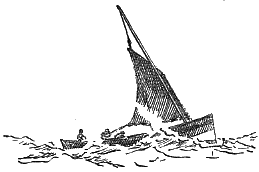 FIFIE,
WITH RAKED MAST FIFIE,
WITH RAKED MAST
The lug rig is more than holding its
own among the Scotch of the east coast. For this there
are probably several reasons. First, the smack-rigged
boats that have been discarded were getting too small,
and their owners going in for larger boats preferred the
rig they were accustomed to. Secondly, many of the
smack-rigged boats were rather flat below the counter,
and thus struck hard in a seaway. The counter is not a
favourite among fishermen, and apparently they are easily
put off it back to the old build, and with that to the
old rig. The Moray Firth sailmakers have not had a tithe
of the experience of making smack sails that they have of
lugs. The result is that they have attained to a high
state of perfection in making lugsails (and in fact in
their own way turn out sails as good as anything made by
yacht sailmakers) ; but they have not made the same
progress with fore-and-aft sails, and really do not turn
out the same class of work when they get an order for the
latter.
Then the simplicity and lack of gear
about the lug rig, and the handiness with which
everything can be unshipped, makes it par excellence the
sail of the drift-net fisherman.
SMACK-RIGGED FIFIE, DUNDEE
Finally, the modern shape of
high-peaked lug, into which the old-fashioned
squareheaded sails have developed, is unequalled for set
and speed-giving power.
Smack-rigged Herring-Boats
*1*
Among the villages lying between
Fraserburgh and Macduff, the smack rig came a good deal
into favour during the seventies and eighties, but of
recent years curiously enough, the tendency has been to
drop this rig in favour of the lugsail.
*1* i.e. cutter-rigged, or in some cases with a mizen.
The term is used among fishermen for any fore-and-aft
rigged vessel, whether strictly cutter, dandy, or
ketch-wherever, in fact, the gaff and boom mainsail is
used as opposed to the lug rig.
The fishermen belonging to these
villages have, for the greater part of the nineteenth
century, regularly fished cod and ling in the Minch from
Cape Wrath southwards to Barra Head and Mull ; they have
also followed the herring fishing at Stornoway and other
stations in the Hebrides ; and during the last quarter of
the century they have regularly prosecuted both the long
line and herring fishings among the Orkney and Shetland
Islands. In the narrow lochs and sounds of these waters
this rig was found very convenient and easy to work. It
was a handy rig for 'beating in' lines, and free from the
risk to life incident to staying a lugsailed boat.
Fishermen also found it much more economical. A smack's
sails will, it is said, last longer than a lugger's ; and
owing to the support given by shrouds or standing
rigging, there is much less risk of the mast carrying
away. With lugsailed boats such accidents are quite
common ; and even apart from accidents, the cost of
upkeep of masts and spars is very heavy.
Upon a long course, however, and in
light winds, the lug rig has been found to be undoubtedly
the faster of the two. Owing to the great distances that
the Scotch fishermen have lately been going, both to the
fishing-grounds off their own coasts and to distant
stations such as Yarmouth, Kinsale, and Shetland, and the
fact that auction sales have almost entirely superseded
the old 'engagement' system, it has become imperative
that fishermen should get as early to market as possible,
as first arrivals usually command the best prices. They
therefore look now upon speed as a necessity, and not
merely an advantage or a matter for pride.
FIFIE RUNNING FREE
Second-hand smack-rigged boats
are eagerly bought up by the Shetland fishermen, who
have, for many years, kept in touch with the villages
where these boats could be got. When none were for sale,
their orders for new boats have generally been placed
with carpenters in that locality. These Shetland
fishermen have only used big boats in the herring fishery
for about a quarter of a century.
Being accustomed to smack-sails in the
vessels used at the Faroe and Iceland cod fishing, and
having experience of similar sails in trading vessels,
they have taken much more readily to smacks than to
luggers.
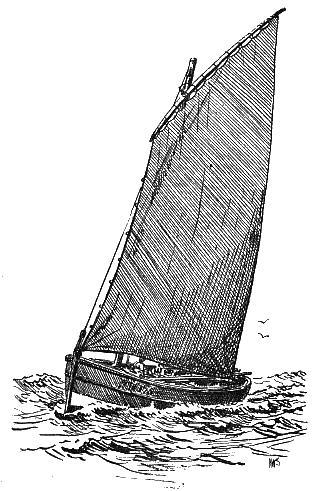 FIFIE
ON A WIND FIFIE
ON A WIND
A good many of these old smack boats
are also to be found along the west coast of Ross-shire,
in Loch Broom, Gairloch, etc., where they suit the narrow
waters, and can be worked either as fishing or trading
vessels, by a much smaller crew than a lugsailed boat
requires.
It may be noted that many of the young
Highlanders, like the Shetlanders, sail in the merchant
service in winter, and go as hired fishermen from the
Moray Firth ports in summer. When two or three of them
wish to settle down at home, they find it a good plan to
bring home a boat, preferably a smack, with them from the
east coast.
The Skaffie
From Portsay westwards along the Banff
and Moray coasts, and round the eastern seaboard of
Ross-shire, until within the last twenty years,
the
Skaffie *1* or 'Buckie Skaffie,' as it
was often known, was universally used in the herring
fishing. This boat differed materially from the Fifie
model. Both stems *2* were very much raked, and the
forestem was generally much curved. The Skaffie was
broader, with a flatter bottom (though generally deep
keel), and with a consequent bluffness about the bow and
quarters. Fishermen found this boat much readier to
answer the helm in stays than the old Fifie model, and
this was a great advantage when 'beating in' lines, or
beating into a narrow bay channel. The old-fashioned
Fifie did not turn readily when under low
sail.
*1* Houldsworth in his Deep-Sea Fishing, 1874,
mentions these boats under the name Scaith.
*2* It will he noticed that in Scotland, where
double-ended, or bowed, or sharp-sterned boats, as
sailors variously term them, are the rule, the term
'stem' is used to cover both stem and stern
posts.
Beating into such places as Wick Bay
or Stornoway Loch the Skaffie showed a decided
superiority. There was also more deck-room on the Skaffie
in proportion to the tonnage of the boat, and this was an
advantage at the herring fishing, especially twenty-five
years ago, when the boats were much smaller than they are
now.
OLD SCAITH, 1874
Advocates of the Fifie model argued
that shortness of keel had certain drawbacks as well as
advantages, and that a Skaffie when struck on the quarter
by a heavy sea would be much more liable to broach to
than a Fifie ; and that the former boat, from the
construction of the bows, would also labour harder in
heavy weather. It is said that it was no unusual thing
for one or two timbers to be broken through slamming in a
head-wind and heavy sea.
In this evenly matched contest of two
very distinct types of craft, it may be inferred that
neither model possessed any material advantages over
the
other, otherwise the fittest would
have survived and the other would have been discarded,
whereas in fact a compromise has been the result, of
which the modern Zulu is the outcome.
The rig of the Skaffie did not differ
greatly from that of the Fifie.
SKAFFIE 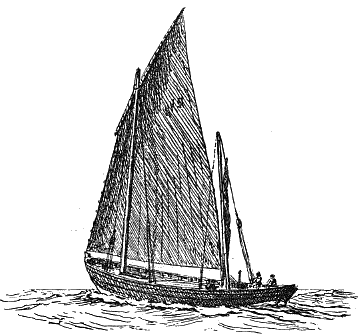
The most noticeable point of
difference was a much greater proportionate breadth in
the lower half of the foresail. Owing to the shortness of
keel, especially at the forefoot, this was required to
keep the boat to the wind.
Houldsworth, *1* however, figures a
scaith of his day as carrying what was practically a main
lug, though slightly smaller than the big forelug, well
in the middle of the boat, with a small mizen right aft
sheeted to a short boom.
*1* 1874. The dimensions given are 41 ft. over all, 13
ft. beam, 4 ft. 9 inches depth of hold. The large
Fifie of that day was 34 ft. 6 inches over all to 13
ft. beam.
SKAFFIE
This rig seems to have gone out
of fashion, the forelug being increased in size, along
the foot, and given greater peak, as in all the Scotch
lugs of the present day, and the mainsail carried further
aft, and turned into a large mizen.
It is interesting to note that at that
time the mizen even in the Fifie was placed so far
amidships as not to need an outrigged boom, and to be
termed by Houldsworth a 'main' lug, and he goes so far as
to point out the great advantages to be derived from the
mizen as used by English fishermen. A spar bowline seems
to have been used in the scaith to set taut the luff of
the sail, called by the Scotch fishermen a 'wand' or
'set.'
The Zulu
William Campbell of Lossiemouth was
the first fisherman to attempt to combine the good points
of the Fifie and the Skaffie models.
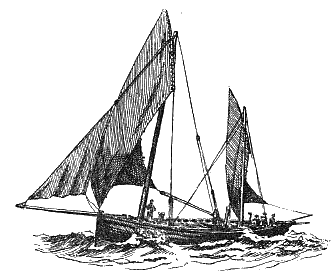 SEVENTY-FOOT
ZULU SEVENTY-FOOT
ZULU
In the year 1878 he got a boat built
named the Nonesuch, with the fore stem and bows of a
Fifie, and the stern modelled on the lines of a Skaffie.
Fishermen at once dubbed the new model Zulu, from our
then redoubtable enemies in South Africa. This boat came
rapidly into favour with the Moray Firth fishermen, and
has entirely superseded the Skaffie. A few of the latter
are still to be seen in use at the smaller stations in
the upper part of the Moray Firth, but none have been
built for many years.
The Zulu is also to a certain extent
supplanting the Fifie, as a few boats of this description
are being introduced all along the east coast, even as
far south as the Berwick district. The introduction of
steering wheels some fifteen years ago instead of helms
or fillers has facilitated this innovation. Fishermen who
had not been accustomed to it from their boyhood found
great difficulty in shipping a Skaffie's rudder, which in
the days when helms were used was always unshipped and
taken on board the boat as soon as the nets were shot at
night. The worse the weather, the more arduous the job
when the rudder had to be shipped into position again
after the nets were hauled in the morning. This
difficulty has now been removed by the introduction of
the wheel and fixed rudder.
The advantages claimed for the Zulu
are, that it stays as well as a Skaffie, and will lie as
close to the wind and go as easily through a heavy
head-sea as a boat of the Fifie build. The deep fore-foot
gives greater grip to windward, and prevents that falling
off from a head-sea which is often so dangerous. The
length of the boat above water, too, admits of a great
spread of canvas in light winds, with consequent increase
of speed. *1* It is curious that in the modern Zulu we
find the straight forefoot combined with the raking
stern-post and sharp stern which are to be seen in some
of the Brittany luggers in the Bay of Biscay, and which
have long been used in the Cornish luggers. The raking of
the stern-post has been much increased in some of the
latter of late years, just as in modern yachts. It
enables the under water-lines of the body to be carried
out more finely without resorting to a long counter, and
consequently adds to the speed as well as to the
turning-power of the boat.
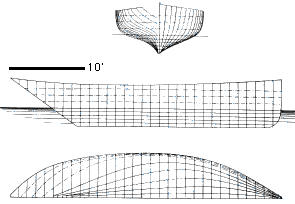
*1* The largest Zulus run to 61 ft. keel and 88 ft. over
all. When driving hard, a whole fleet of these boats will
be logging over 10 knots together.
In one respect all the Scotch boats,
of whatever build, contrast remarkably with the Cornish,
and that is in the relative draught of water at bow and
stern. The Cornish boat draws considerably more water aft
than forward, and has consequently greater lateral
resistance aft, and the centre of lateral resistance
being so far back, a proportionately larger mizen and
less head-sail become necessary.
The Scotch boat on the other hand
which has to some extent grown, at all events in the case
of the Fifie model of the east coast, out of a deep-bowed
boat of coble type, has always retained a relatively deep
and powerful forefoot and bow, and a shallower stern. The
result is that the Scotch boat has been more of a
one-sail boat, and having the centre of lateral
resistance much further forward, the mizen has never
played such an important part as in the Cornish
lugger.
The Cornish boat when lying on the mud
has the appearance of being tilted forward by reason of
her deep keel ; the Scotch luggers, on the other hand,
lie in their tidal harbours on a fairly level keel, and
strike the observer by reason of the concentration of
power forward. To this and to the large size to which the
big
Fifies and Zulus now run, we are
indebted for what is certainly the most remarkable single
sail to be met with upon the seas outside the lateen,
namely, the tall Scotch fore-lug. It is truly one of the
finest sea sights of modern times to see this great brown
pyramid come marching up out of the horizon, and go
leaning by you at a ten-knot speed, the peak stabbing the
sky as it lurches past some seventy feet above the water.
The sense of strain and power is not so produced by any
work of man at sea.
The unanimity with which Scotch
fishermen as a whole have clung to the pointed stern is
remarkable.
About the borders of Aberdeenshire and
Banffshire a good many boats have been built with
elliptical or counter sterns during the last thirty years
or so. They were first built and owned at Pennan village,
but they became fairly fashionable at Rosehearty also
about a dozen years ago, and there are still a few in the
neighbourhood. Like the Skaffies and Zulus, these boats
bad more deck space in proportion than an ordinary Fifie,
and this was at first a far greater advantage than it is
now, when all boats are so large. The tendency, however,
has lately been to revert back to the Fifie model, the
disadvantages of the counter being generally considered
by fishermen to outweigh its advantages.
Small Line Boats
Distinctive local types of small line
boats are not so clearly marked or territorially limited
on the east coast of Scotland as are the larger
herring-boats. For inshore fishing, a long-shaped,
low-built, open yawl of from 15 to 25 feet of keel, with
lugsail and, in the ease of the larger yawls, jib, and
occasionally also mainsail or mizen, used to be generally
employed. The size of the boat depended a good deal upon
the nature of the harbour or creek to which it belonged.
On open beaches, where the yawls had to be launched
daily, and drawn up again after returning from sea, it
was imperative that the boat should be as light as
possible.
LONG LINE BALDIE
As a result, the small line yawl used
open creeks such as Cairnbuig and Inverallochy (near
Fraserburgh) were low in the wood, of as light material
as consistent with safety, and of very light draught of
water. They could thus be easily floated off a flat
beach, and they required no great quantity of ballast,
which of course had to be put in and out daily. The
timbers were 'stove-bent,' i.e. steamed then bent into
shape. Only the best of wood stands this process, and
much lighter material could used than with hewn timbers.
In other words, these boats were built largely with a
view to being easily pulled, as the small lines were
generally worked under oars.
After fishermen had realised the
advantages of having decks on herring-boats, they were
not slow to apply the same improvement to their smaller
boats, and now practically every fishing-boat round the
Aberdeenshire coast, of 15 feet keel and upwards, is
wholly or partially decked. Hatches are not generally
used in boats under about 28 feet keel ; but even in
these, waterways along the sides have been found most
valuable in numerous cases where boats have been struck
by sudden squalls which forced lee sides under water, or
by heavy seas which but for the deck would otherwise have
swamped them.
In such places as Fraserburgh and
Peterhead, where there are safe harbours that can be
taken at all states of the tide, the winter yawls are
much larger, running up to 33 and 35 feet keel. These
boats are built more after the model of a herring-boat
(Fifie build) ; they are of strong material, full decked
and hatched, and heavily ballasted. They have forecabins
with sleeping and cooking accommodation for a full crew.
They are rigged like the herring-boats, and the lines are
worked under sail. Five men generally constitute the
crew, both for small line and great line
fishings.
These larger boats, from 25 feet keel
and upwards, are generally known in Aberdeenshire and
southwards as Baldies (or in Fifeshire parlance as
'Bauldies'). The name is a contraction for 'Garibaldi,'
and was originally used in full in Aberdeenshire. Skiff
is more generally applied to this boat among the eastern
villages of Banffshire.
From the Deveron westwards along the
shores of Banff and Moray, and to a great extent also in
the Firths of Forth and Tay, fishermen have generally
preferred to work small lines in their large herring
boats, as they also work great lines.
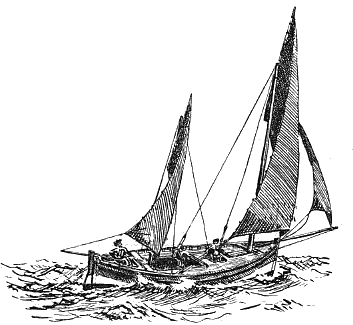 NEWHAVEN
BALDIE NEWHAVEN
BALDIE
At Newhaven, however, the Baldie seems
to be sufficiently large to answer most of the
requirements for fishing in the Firth of Forth, and a
good many boats of the same kind are also used among the
East of Fife villages, especially during the winter
herring-fishing.
At other places on the east coast, for
instance Fraserburgh and Peterhead, the tendency of
recent years has been to use the large 60-feet
herring-boat for all purposes,
including small line fishing. With the increased
attention paid to the herring fishing at Yarmouth during
the late autumn, and on the Scottish coasts during the
early months of the year, many fishermen do not now think
it worth while to keep a winter yawl. *1*
Zulu Skiffs
Small line boats of the Skaffie model
were to be found at most of the Moray Firth ports where
Skaffies were employed in the herring fishing, but not in
such numbers as to constitute a distinct type of boat.
The principal reason, no doubt, was that most of the
able-bodied Banff and Moray fishermen preferred to use
their big herring-boats for all purposes. But even where,
from want of proper harbour accommodation or any other
cause, small boats were used, these were often of the
Fifie model. Fishermen from as far up the Firth as Tain
and Broca have for long been in the habit of getting
their small line boats built at Rosehearty, near
Fraserburgh.
Since the Zulu was introduced,
however, yawls of this model have been coming rapidly
into favour, not merely in the home of the Skaffie, but
round Aberdeenshire, etc. Fraserburgh fishermen, who used
to adhere rigidly to the Fifie model, were among the
first to introduce this innovation, and to recognise the
suitableness of the Zulu for line fishing.
*1* A winter skiff of the Fifie model, built at
Peterhead in 1890 to the order of a Banffshire crew,
measured 37 ft. keel and 42 ft. 6 inches over stems,
15 ft. beam, 5 ft. deep, and 15 tons register. Price
to carpenter, £71, and for sails, etc., £30.
This, of course, cannot be taken as the present cost
of a similar boat. The boat was clinker-built ; a
carvel craft would have cost more.
During the last few years a good many
large Zulu skiffs have been built at Fraserburgh and
other Moray Firth ports, to the order of the Congested
Districts Board for Ireland, for use on the north-west
coast of that country. They are used both for long line
and for herring fishing, and have given entire
satisfaction. Crofter fishermen belonging to the
Congested Districts of Ireland get these boats from the
Board on the loan system. *1* Skilled fishermen from the
east coast of Scotland are put in charge as instructors
at the Board's expense for a limited period, after which
the crews are expected to be able to manage the boats
themselves. At great line fishing most of these boats
have hitherto worked in Donegal Bay during the first part
of the year, and in the autumn they have been mostly
employed in Downings Bay (Sheep Haven) at the herring
fishing. >>Next
Part
*1* These Zulu skiffs that have been taken to Ireland run
about 30 ft. keel and 42 ft. over stems ; 12-1/2 ft.
beam, 5 ft. deep inside, and 10 tons register, and are
mostly carvel-built. There is, of course, cabin
accommodation for a full crew. Cost for carpenter work,
£100 ; and for sail and outfit, £35 ;-total,
£135. Material is much dearer now than a few years
ago.
|


 FIFIE,
WITH RAKED MAST
FIFIE,
WITH RAKED MAST FIFIE
ON A WIND
FIFIE
ON A WIND
 SEVENTY-FOOT
ZULU
SEVENTY-FOOT
ZULU
 NEWHAVEN
BALDIE
NEWHAVEN
BALDIE